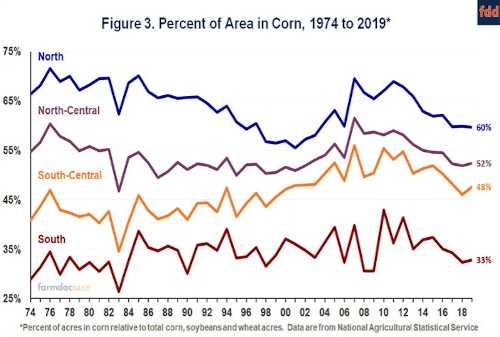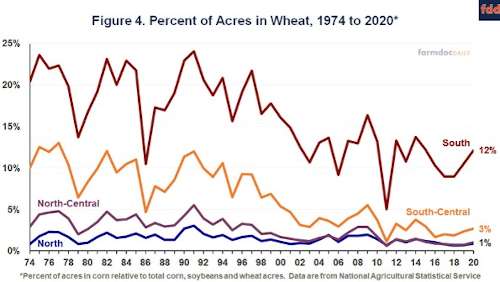Acreage Shifts Across Illinois
Acres devoted to corn, soybeans, and wheat vary across the state, as illustrated in Figure 2. The map in Figure 2 divides Illinois into four regions:
- The north region includes two Crop Reporting Districts (CRDs) in northern Illinois named the Northwest and Northeast districts,
- The north-central region includes three CRDs in central Illinois (West, Central, and East),
- The south-central includes two CRDs in the middle part of the state (West southwest and East southeast), and
- The south region consists of the two southern-most CRDs (Southwest, Southeast).

Percent of total acres planted to corn is the highest in the northern region and lowest in the more southern areas. The north region had 60% of acres in corn in 2019, the north-central had 52%, south-central had 48%, and the south had 33% (see Figure 2).
As a result, a larger share of acres is planted to soybeans in more southern regions. Soybeans constituted 39% of acres in the north region, 47% in the north-central region, 49% in the south-central region, and 55% in the south region.
The percentage of wheat acres also increased for the more southern regions. The north and north-central regions had a very small proportion of their acres in wheat (1%). The south-central had 3% in wheat, and the south had 12% in wheat.
Over time, the relationship of crop acreage in the four regions has remained relatively stable (see Figure 3). The north region has always had the highest percentage of acres in corn, the north-central region the second most, the south-central the third most, and the south the least. Changes in any given year are roughly proportional across the regions.

Over time, acres in wheat have declined, reaching what appears to be a relatively stable level of between 500,000 to 700,000 in acres in Illinois. The proportion of acres in wheat in the north and north-ccentral regions have been relatively low (see Figure 4). From 1990 to 2006, the proportion of wheat acres declined in both the south-central and south regions.

Summary
Acreage history suggests that total corn, soybeans, and wheat acres in Illinois will total in the range of 20 to 20.7 million acres in 2021. Current economic conditions would suggest a shift from corn to soybeans. If this does occur, one would expect all areas of the state to make roughly the same proportional change. Historic relationships likely will persist and northern Illinois will grow more corn than soybeans while southern Illinois will grow more soybeans than corn.
Source : illinois.edu